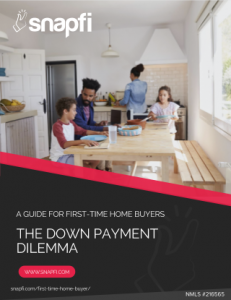
Like jello molds for new neighbors and fruitcakes at Christmas for the postman, the “20 percent down payment” idea is one passed down from generation to generation without much thought or question.
It’s just something you’re supposed to do, right?
It’s smart.
It’s what mom said to do.
It’s American.
As I’m sure your mail carrier would tell you, it’s time to reevaluate all those inherited habits–and fast. Because the truth is, just like Mr. and Mrs. Smith aren’t interested in that wiggly, jiggly welcoming gift, a 20 percent down payment isn’t necessary anymore–nor is it really practical.
Years ago (before the Federal Housing Administration was created in the 1930s), homebuyers were expected to put down 20 percent when purchasing their house. But today? That couldn’t be further from the truth.
Today’s homebuyers actually need much less than that–and some loan programs even waive down payments altogether.
So if buying a home is on your radar, don’t let that old 20 percent down myth get you down. Whether you’ve got thousands in the bank or no savings at all, there are plenty of routes to homeownership–you just have to know where to look.
Option 1: Low Down Payment Loan Programs
There a several loan programs that will let you take out a mortgage without anywhere near 20 percent down. Some require as little as 2 to 3 percent, while others ask for no down payment whatsoever.
The most common option is the FHA loan. Popular with many first-time buyers, FHA loans require a minimum down payment of only 3.5 percent. On a $500,000 home, that’s just $17,500.
Other options include:
- CalHFA loans – Available to California residents only, these are FHA-backed loans that can be combined with other state programs to offer buyers low and no-down payment options.
- Arizona Home Plus – Available in Arizona, this is a 30-year fixed Home Plus Loan and a Home Plus grant of 2-5%, specific to the loan program you choose. The grant can cover your down payment and/or closing costs and you don’t have to pay it back!
- Conventional loans – These require anywhere from a 3 to 5 percent down payment, depending on the value of the home and your credit history. Freddie Mac’s Home Possible Advantage and Fannie Mae’s Conventional 97 are some of the more popular conventional loan programs on the market today.
- USDA loans – In rural communities, the U.S. Department of Agriculture offers loans that require down payments as low as 2 percent.
- VA loans – Issued by the Department of Veterans Affairs, VA loans are reserved for military members, veterans and their family members. Many VA loans require no down payment at all and also cover some, if not all, of your closing costs.
You can also take out two mortgages at once, wherein one loan covers 80 percent of your home, and the other covers 5 to 10 percent of it. Typically called piggyback loans, these require a 5 or 10 percent down payment up front.
Option 2: Other Alternatives
Choosing the right loan program is only the first step toward making homebuying more affordable. If you’re still not able to manage the required down payment or need further financial assistance, there are many more avenues you can take to get there.
You can:
Get a gift.
If your parents, grandparents or other loved ones are the generous sort, they can help you out by covering all or part of your down payment. There is a catch, though: If you’re not doing 20 percent down, they can’t cover all of it. You’ll at least need to pay a small portion of the down payment out of your own funds.
Find a co-borrower.
Having trouble qualifying for a good loan program or interest rate? Consider co-borrowing your mortgage loan with a friend, roommate, significant other or family member. Through this, their income and assets will be considered in your mortgage application, likely qualifying you for better rates and, possibly, a lower down payment.
Seek out local housing grants and down payment assistance programs.
Cities, states and other municipalities often offer grants and programs to help draw more residents to the area. In California, for example, there’s the MyHome Assistance Program, which lets you defer payment on up to 3.5 percent of your purchase price to help with your down payment. There’s even a program specifically for teachers in the Golden State. Dubbed the Extra Credit Teacher Home Purchase Program, ECTP offers up to $15,000 in down payment assistance. In Arizona there is the Home Plus Grant, detailed in the above text.
Be sure to check with the state and city you’re buying in, and research any potential assistance programs you may be eligible for.
Borrow.
It might not be the ideal situation, but if friends or family are willing, you can borrow funds to put toward your down payment. Just be sure you put down in writing a clear-cut plan for repayment; you don’t want money (or the lack of it) to come between you and your loved ones down the line.
Don’t Go All In
Even if you do have a lot in savings or your pockets are deep, there’s no reason to put 20 percent down unless you really want to. With today’s rising healthcare costs and fickle job market, having a rainy day fund is very important.
Plus, remember your mortgage payment isn’t the only cost of homeownership. There are tons of other costs associated with owning and maintaining a home. From the lawn service you hire to weed your garden to the electricity, gas and water bills you pay every month, they all cost cash on a regular basis. Make sure you have enough in the bank–and then some–just in case.

FREE eBook: The Down Payment Dilemma
If you’re ready to see how SnapFi can help you buy your first home get in touch with us today.



